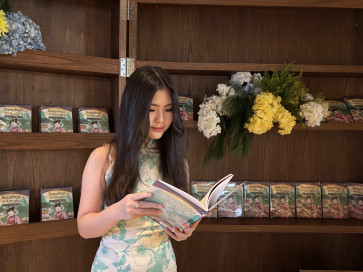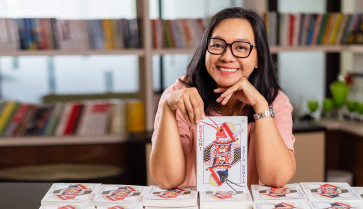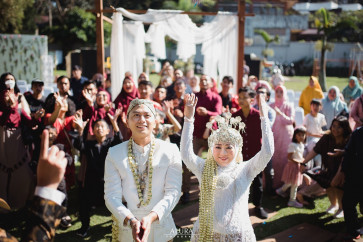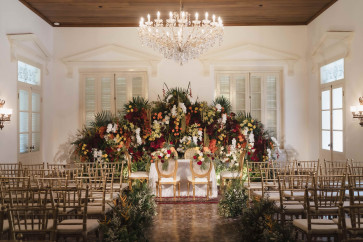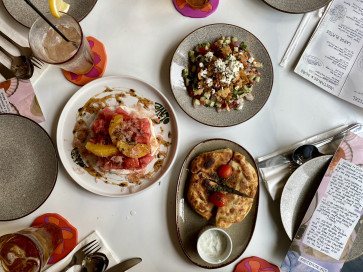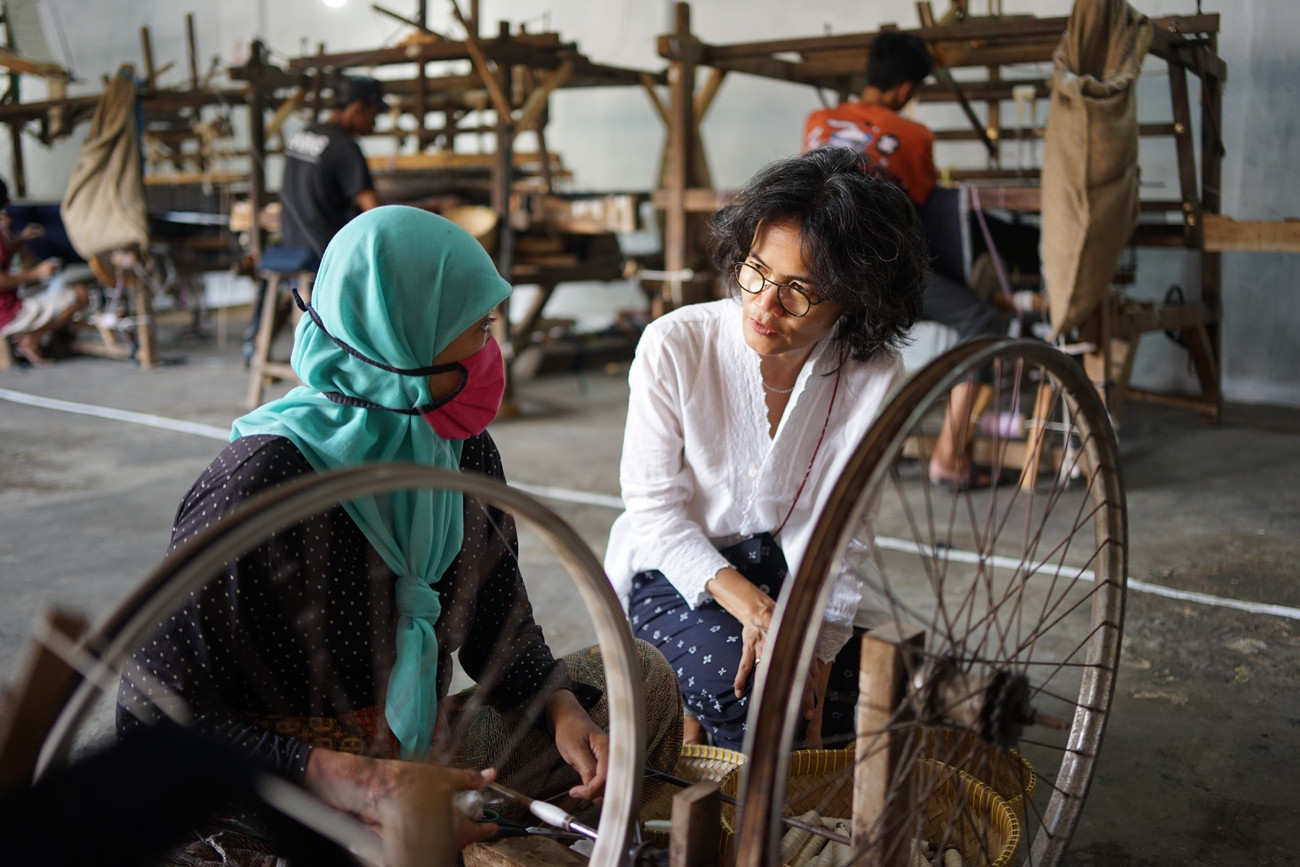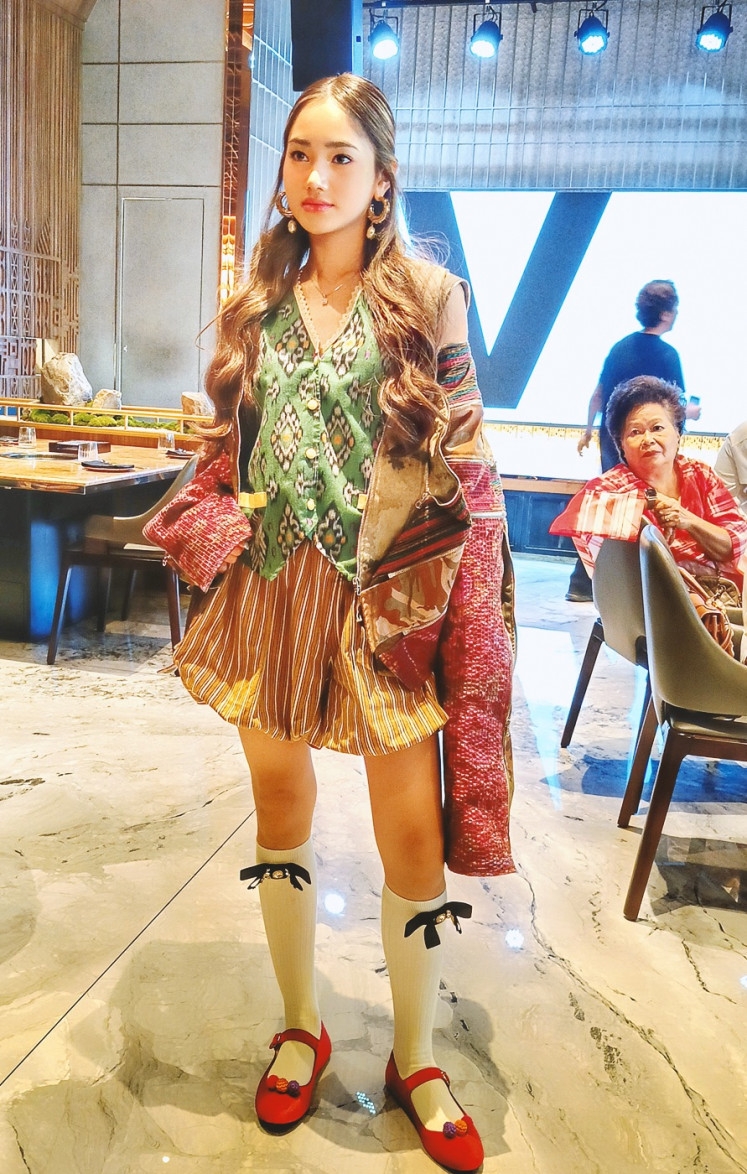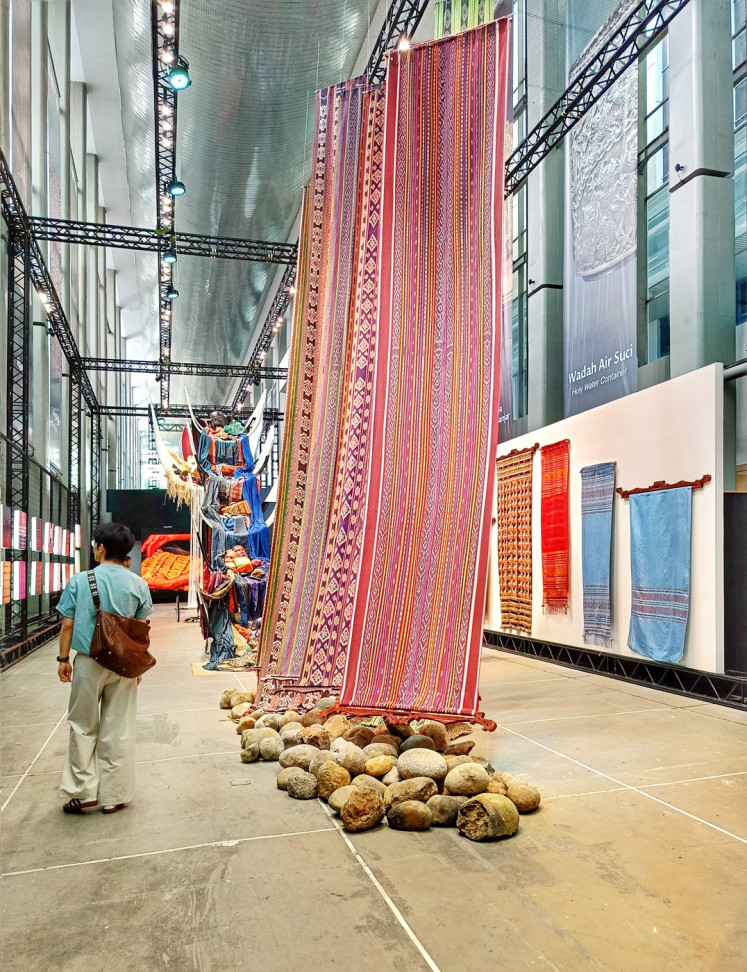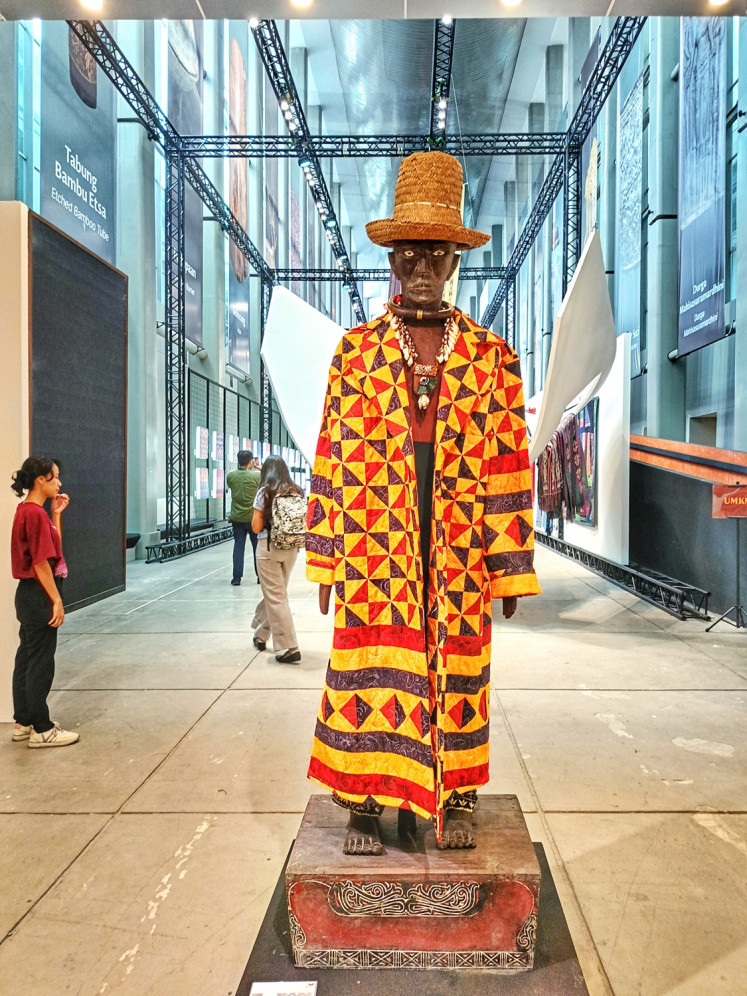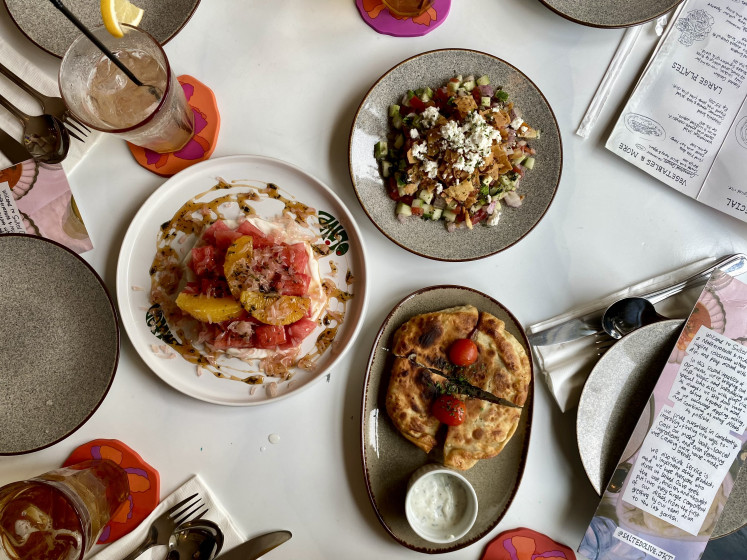Chitra Subyakto (right), founder of “nature-positive” fashion label Sejauh Mata Memandang, speaks with a weaver at her workshop in Pekalongan, Central Java.
Standing before rows of multicolored tenun extending from the floor to the ceiling at “The Flying Cloth” exhibition, held from Nov. 11 to 24 at the National Museum, I couldn’t help but marvel at the intricate craftsmanship and countless hours woven into each thread.
Every motif tells a story, reflecting the region’s natural wealth and cultural wisdom, yet the beauty of tenun (traditional textiles) had long been under appreciated.
Tenun has risen only recently to fashion’s forefront, gracing runways, exhibitions and modern wardrobes in a revival driven by artisans, designers and advocates who are passionate about preserving the traditional craft and integrating it into today’s world.
At the heart of the exhibition, tradition comes alive in the deft hands of Rukayah, a Baduy artisan weaving a Pikara Tinun on a traditional backstrap loom during a live demonstration.
The strap snug against her lower back, she leans forward, her hands moving with practiced ease to create the ornate Suat Songket motif. The rhythmic swish, creak and thud of the loom fills the hall, a meditative echo of heritage and skills.
“I’ve been weaving since I was 12,” says the mother of two, her hands never faltering.

Thank you!
For signing up to our newsletter.
Please check your email for your newsletter subscription.
It takes Rukayah at least 15 days to weave a length of fabric measuring 1 meter by 2 meters, all while balancing household chores. She then sells her creations to tourists visiting Gajebo, her home village located in a Baduy Luar (Outer Baduy) community in Banten’s Lebak regency, to supplement her husband’s income as a farmer.
Revitalizing tradition
Almost every region in Indonesia has a textile heritage with distinct techniques and motifs, yet this cultural wealth is often overshadowed by the more familiar and readily available batik.
Price is often a deterrent for those who appreciate tenun: A single handwoven shawl can easily cost hundreds of thousands to millions of rupiah, depending on the quality and craftsmanship.
“Of course they’re expensive, and rightly so,” says Sjamsidar Isa, head of quality control at Cita Tenun Indonesia (CTI).
“Each piece can take months to complete, involving many skilled artisans, from spinning and dyeing threads to weaving. The earnings should benefit them all.”
A nonprofit founded in 2008 by textile enthusiasts and collectors, CTI has played a pivotal role in preserving tenun, connecting weaving communities with fashion, interior design and management professionals. These collaborations help weavers refine their skills, creativity and business acumen, and CTI has trained and supported weavers in more than 28 cities and regencies so far.
“See, these weavers mostly work from tradition,” Sjamsidar explains.
“What we do is show them that tenun can also serve purposes beyond the traditional, in modern design and everyday use.”
The organization also runs the Professional Certification Institute (LSP) under the National Professional Certification Agency (BNSP), which offers certification to weavers, natural dyers and artisans specializing in traditional motifs. Since its inception in late 2023, CTI’s LSP has already certified 240 weavers and 60 natural dyers.
Reimagined textiles
During the Fashion Nation showcase on Sept. 25 at Senayan City in Central Jakarta, at least two labels favored by millennials and Gen Zers – Money Man Works and Qanagara– reimagined tenun with fresh, contemporary styles.
Money Man Works captivated the audience by merging tenun with denim, crafting bold, American street-style clothing including crop tops, harem pants, Bermuda shorts and deconstructed jackets.
A sassy streetwear outfit featuring a Tenun Lombok jacket by Money Man Works, a Tenun Endek Bali blouse by Toko Didiyo and Tenun Lurik shorts by Qanagara is was showcased on Sept. 25 in CTI’s fashion show during Fashion Nation at Senayan City, South Jakarta. (JP/Sylviana Hamdani)
Qanagara paired Tenun Lurik Solo, Tenun Endek Bali, Tenun Sobi Muna and Tenun Ikat Sengkang with tulle and tweed, creating a chic, versatile collection.
“Tenun isn’t just for traditional settings,” says Qanagara’s creative director Qiara Amarullah. “With the right designs, it can work everywhere, from the office to evening socials.”
Naturally dyed tenun from East Nusa Tenggara’s Alor Island are suspended from the ceilings of the National Museum in Central Jakarta during “The Flying Cloth” handwoven textile exhibition, which ran from Nov. 11 to 24. (JP/Sylviana Hamdani)
At Jakarta Fashion Week in late October, designers Asha Smara Darra, formerly known as Oscar Lawalata, Era Sukamto and Felicia Budi presented prêt-à-porter collections crafted from tenun.
Asha reimagined West Sumatra’s Tenun Halaban into kebaya-inspired blouses paired with relaxed pants, blending elegance with casual ease. Era brought a regal touch to West Kalimantan’s Tenun Cual Sambas by transforming it into evening wear, while Felicia turned Southeast Sulawesi’s Tenun Sobi Muna into dynamic streetwear, inspired by 1950s workwear.
A Batak sigale-gale puppet, dressed in a sacred priest's jacket crafted from Batak Mandailing ulos with intricate patchwork designs, is displayed during “The Flying Cloth” handwoven textile exhibition at the National Museum. (JP/Sylviana Hamdani)
This year, CTI also worked with interior designers to transform Sumbanese textiles into refined upholstery for modern furniture. Showcased at the FIND Design Fair Asia in Singapore on Sept. 26-28, the resulting pieces demonstrated how traditional textiles could enrich contemporary interiors.
“Indonesia’s handwoven textiles are ideal for interiors because of their thick, durable fibers,” Sjamsidar explains.
“This also benefits weavers, as interior products require more fabric.”
Sustainable threads
Textile and fashion designer Merdi Sihombing advocates for integrating tenun into modern fashion as well as enhancing their quality.
At his fashion show on Nov. 16 during the The Flying Cloth exhibit, Merdi showcased natural dyed tenun, including some pigments sourced from daily food waste like turmeric, carrot and jengkol (dogfruit) peels from a hotel kitchen in North Sumatra. His catwalk models were women bankers and politicians, who showcased his vibrant tenun creations reimagined as baju kurung (tunic-skirt set), trench coats and tailored suits.
"Some believe natural dyes can’t create bold colors," the designer says. "But as you can see, that’s not true."
Merdi’s research also highlights the environmental benefits of natural dyes, which can reduce carbon emissions by up to 40 percent compared to chemical alternatives.
Chitra Subyakto has also been revitalizing tenun through her label Sejauh Mata Memandang by exclusively using “nature-positive” materials such as natural fibers and natural dyes, as well as chemical dyes certified environmentally safe.
“We’re living on a planet that’s literally boiling,” Chitra says.
“So fashion should always consider the environment and the people affected by it.”
She believes the renewed recognition of tenun stems from people rediscovering the value of their textile heritage.
“Indonesian wastra [traditional fabrics] have been passed down through the generations, a tradition we’ve somewhat forgotten in this fast-paced world,” she says.
“But when we reconnect with these ancient practices, we realize they help restore balance to the Earth, slow down the rush and bring harmony.”
Chitra also sees millennials and Gen Zers embracing traditional textiles.
“As long as the products are beautiful, responsibly made and versatile enough to mix with their existing wardrobe, they’ll be drawn to them,” she says.
Everyday ‘tenun’
One such textile enthusiast is Ary Ogam, who pairs tenun or batik with his daily outfits, whether he is in the office or out with friends. With over 200 pieces in his collection, the thirtysomething consultant especially treasures his naturally dyed vintage tenun from Kalimantan, his home region.
On his Instagram account (@Instogram), Ary shares innovative ways to style kain (fabrics) and sarong with modern staples like T-shirts and jackets to inspire his 24,900 followers.
“The positive feedback has been overwhelming,” he says. “Some followers even tag me when they wear kain or sarong inspired by my posts.”
As a devoted wearer of wastra, Ary is passionate about the future of tenun: “I hope people keep wearing them. Supporting our SMEs [small and medium enterprises] is crucial to preserving this heritage.”
Baduy weaver Rukayah echoes his sentiment, explaining that the future of tenun is closely tied to the livelihoods of female weavers in her community.
“If our tenun keeps selling well, the women in my village and I can keep weaving, preserving the craft passed down by our karuhun [ancestors],” she says.
Designer Merdi believes these dreams are within reach.
“With hundreds of tenun motifs, Indonesia is uniquely positioned to be a global center for indigenous fashion,” he says.
Revisiting tenun and its passionate advocates renews my faith in the evolving legacy of this uniquely Indonesian heritage, not merely as a vessel of tradition but as a dynamic force shaping our cultural narrative for generations to come.
Sylviana Hamdani is a journalist with a passion for art, fashion and culture. An adventurer at heart, she explores human creativity and stories through her writing and photography.






